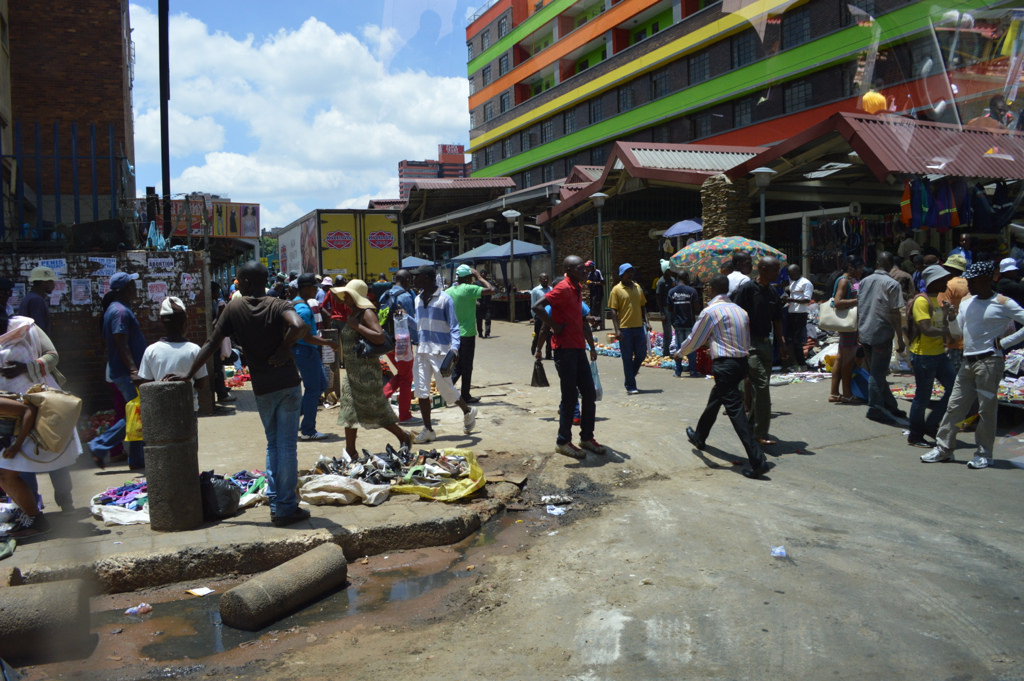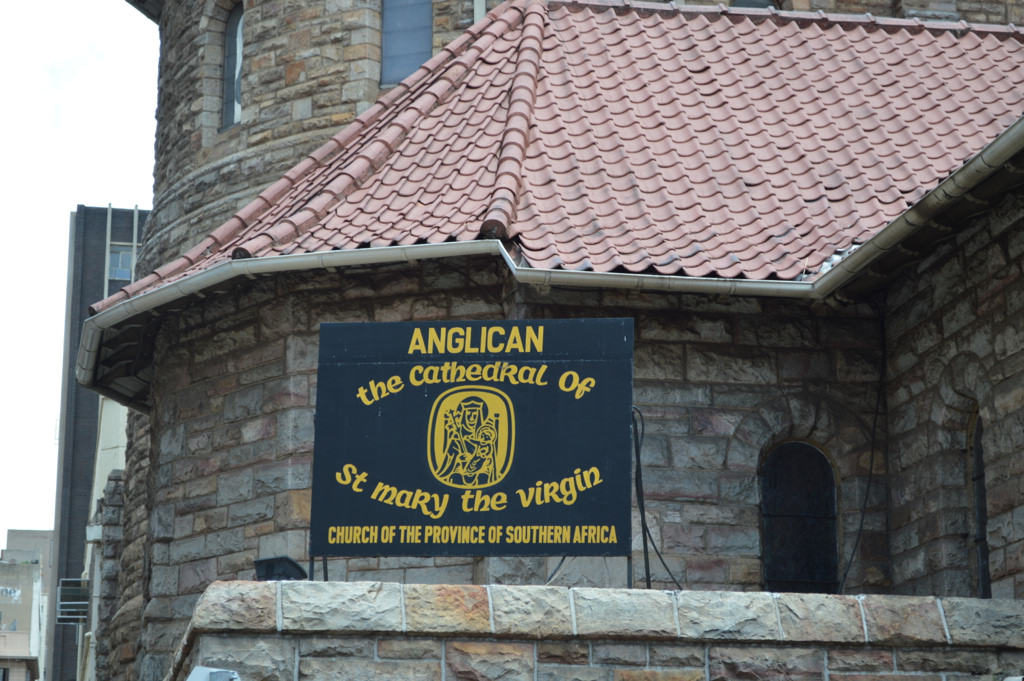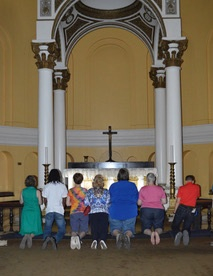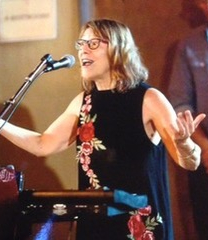Essay by Susan Butterworth
Finding Father ffrench-Beytagh in South Africa

On a balmy evening in January 2014, a motley group of eight seminarians gathered in the living room of a small bed-and-breakfast in Soweto, Johannesburg. We were all students at Episcopal Divinity School in Cambridge, Massachusetts, but diverse in religious and geographic background: Southern Baptist, East Coast Episcopalian, New Mexico Old Catholic (a group that long ago broke ties with the Church of Rome, seeking to emulate the early Christians), Toronto agnostic.
We were straight, gay, and transgender. We came in various ages and styles, wide or narrow, carefully made-up or grungy, folky or straight-laced, fresh-faced or lined with experience. But with one notable exception, we were all white.
Our leaders were Katherine, our spiritual advisor from Cambridge, and her best friend from seminary, Mpho, the daughter of Archbishop Desmond Tutu. Mpho stood out in her braids and African dress. Her mahogany face looked like a rounder, younger version of her famous father’s.
For the rest of us, it was the first time we’d ever been the only white people in a black neighborhood on the other side of the world from home. We’d just endured a seventeen-hour flight from a dark winter morning in Boston to a humid summer evening in Soweto, the township made infamous by a student uprising in 1976 over a policy mandating that all school instruction should be in the Afrikaans language.
Katherine and Mpho led a brief prayer of thanksgiving and intercession. Then they asked each of us to say why we were there and what we hoped to learn from the trip. I considered talking about confronting race and injustice or experiencing history: the Apartheid Museum, the prison on Robben Island, meeting Desmond Tutu, going on safari, the freedom and majesty of wild animals. But nervous as I felt, I said none of the expected things. I was on the trail of another story.
When it was my turn to speak, I blurted out: “I want to go to the cathedral in Johannesburg. I want to write a really dynamite introduction to my thesis on Gonville ffrench-Beytagh.”
The other students looked blank. Katherine and Mpho looked dubious. The cathedral was not on the itinerary.
Mpho knew of ffrench-Beytagh, since her father Desmond Tutu had succeeded him as dean of the Anglican cathedral in Johannesburg. Katherine knew the cathedral, having been there for Father Tutu’s eightieth birthday celebration. But we were in Johannesburg to discover the struggle against apartheid from the black African point of view. We were on a pilgrimage to worship in the townships, to experience the culture of African Anglicans. I knew that Mpho knew I was proposing a very different pilgrimage stop, one that emphasized the story of a white man.
That story is not well known. Yet I’d done a good deal of research and writing about ffrench-Beytagh (pronounced French-BEE-tuh) and the church’s role in apartheid-era South Africa. My thesis focused on a stalwart and faithful man whose belief in God’s universal love led him to concrete and dangerous action for social justice. I needed to hook my traveling companions, and to do that, I’d have to call on the power of his story—and the way that story had personally moved me.
It’s good to hear such stories, to repeat them until they become a part of ourselves. With so much talk about white privilege, internalized and institutionalized racism—even in the church and among Christians—it’s good to hear about a white man who used his position and privilege to take practical steps to help his black brothers.
But more than ever, I believe it’s good to hope—to realize an individual can do something just and concrete, even if the war against injustice isn’t won and may never be.
• • •
Gonville Aubie ffrench-Beytagh (1912–1991) was born in Shanghai to expatriate Anglo-Irish parents. After a chaotic childhood and youth, he went on to become a pivotal figure in the South African Anglican community. In 1965, named the first dean of the cathedral in Johannesburg not born in England, he was the rare white church leader who fostered a multiracial congregation.
By January 1971, he was an experienced pastor as well as a cigarette-smoking, whiskey-drinking friend and benefactor of political prisoners and their families. One fateful day, the 58-year-old dean arrived home to find the South African Security Police waiting. His flat was searched; a box of anti-government leaflets from the African National Congress and the Communist party was “found,” and the police took him to prison.
Ffrench-Beytagh knew he was in danger from the secret police. He’d been actively helping political outcasts, receiving funds from the World Council of Churches (WCC), financing legal aid for those caught in the web of the Apartheid Laws, sending accounts of torture of African political prisoners to England to be published, and paying for wives to travel to visit their husbands in prison on Robben Island.
Held in solitary confinement, with no idea what to expect, and well aware of the torture other prisoners had endured at the hands of the security police, he was terrified. He suffered fits of panic and weeping, yet was sustained by his practice of daily prayer. As ffrench-Beytagh wrote in his 1973 memoir Encountering Darkness:
Underlying my panics and weeping-fits and fear, there was a sense of immense strength upholding me, and surrounding me like a wall. Later, of course, I found that Christians all over the world had been praying for me. I did not know this at the time, but I did feel quite certainly that I was surrounded and protected by a wall of prayer.
Then the interrogation began. In his memoir, he described “vicious verbal violence,” with his interrogators screaming, shouting, and swearing at him, repeating over and over, “You don’t preach Christianity, you preach shit.” Among the shouting tirades were screamed accusations that he was a highly trained communist agent who advocated violent overthrow of the South African government.
 Ffrench-Beytagh emphasized that he didn’t experience physical torture; he had the advantage of white skin and a British passport. After eight days, he was released on bail to await trial under the Suppression of Communism Act.
Ffrench-Beytagh emphasized that he didn’t experience physical torture; he had the advantage of white skin and a British passport. After eight days, he was released on bail to await trial under the Suppression of Communism Act.
He was a great believer in the healing power of prayer. At the same time, he felt that to pray and not take concrete action would be to evade the responsibility of his Christian vocation. As Father ffrench-Beytagh later wrote in Encountering Light, his 1975 book of practical theology: “It is not much good praying for someone if I am neglecting to do something practical about the situation when it is in my power to do so…. [P]rayer always leads to greater involvement with the world.”
• • •
By the time I got to Soweto, I’d lived with ffrench-Beytagh’s story for almost two years—researching, reading, writing emails to people who had known him, pondering, pondering more—while I worked on my thesis for my Master of Divinity degree. He was unapologetically a political priest. What attracted me to his story, though, was his unlikely conversion and calling to the priesthood. I was fascinated by his wild youth. And I wanted to understand the faith that later led this white man to risk his comfortable professional life by standing up for black Africans.
Young Aubie ffrench-Beytagh lived what he called in his memoir “an oddly assorted childhood.” In Shanghai, his father, the managing director of a cotton company, ignored him, and his bohemian mother was distinctly unaffectionate. In their decadent household, drinking and sexual looseness weren’t hidden from the children. Aubie and his younger brother and sister were raised by a succession of nannies, until their mother left abruptly for South Africa with an officer in the merchant navy.
When Aubie was seven years old, his father sent him and his siblings to England with a Miss Newbury, who had been the cathedral organist in Shanghai. Miss Newbury took her guardianship of the ffrench-Beytagh children seriously. She gave them stability and an education at good schools, until their father stopped sending money. Although seventeen-year-old Aubie had seemed headed for a promising academic career, he left England for New Zealand, where he then ran away from school, worked on sheep farms, drank freely, and regularly got into fights.
In 1932, he was in hospital recuperating from one of those fights when an elder half-brother found him and brought Aubie to South Africa to reunite with his mother for the first time in more than a decade. Aubie found work in a mining office in Johannesburg, where he was a lonely outsider. Without enough money to live his mother’s high society life, he spent his free time drinking and partying.
He had, however, the good fortune during this time to meet prison reformer and anti-apartheid activist Alan Paton, later known as the author of Cry, the Beloved Country. Aubie ffrench-Beytagh became involved in Toc H (Talbot House), an international Christian service organization. He was, he wrote in his memoir, living a double life: carousing in nightclubs by night, working on prison reform and teaching African prisoners by day.
In 1936, after a drunken argument over a girl, ffrench-Beytagh was mugged in the subway station on the way home from a party. He was seriously injured—hit over the head with an iron bar, his jaw broken in three places, concussed, in danger of not living through the night. Alan Paton was one of his first visitors when ffrench-Beytagh regained consciousness in Johannesburg General Hospital.
His jaw healed slowly, and he spent a long time lying in that hospital bed, reflecting on his life. He wrote in his memoir:
I believe that if there was a moment of conversion, this was it. I discovered that the people I wanted my children to be like were Christians—completely reckless, daring Christians. And it logically followed that this was the sort of person I wanted to be myself.
Reckless, daring Christians. These words called to me when I first read them and still do. For ffrench-Beytagh, as for me, to be inspired by the example of Jesus is to take risks, to accept and act on God’s boundless and inclusive love in radical, surprising ways.
• • •
Although our original itinerary didn’t include a stop at St. Mary’s Cathedral in Johannesburg, Constitution Hill is not far from the cathedral. After my spontaneous announcement that first night in Soweto, Katherine and Mpho graciously arranged a detour. But even with telephone directions from the church office—and our young guide TK riding shotgun with a local driver—we despaired of finding it. St. Mary’s is the seat of the Anglican Bishop of Johannesburg, a grand Romanesque cathedral, yet somehow we missed it.
We were in a warren of one-way streets, hospital and medical buildings, train and bus stations. There were street vendors and market stalls jumbled together with small shops selling down-market goods, clothing, housewares, cheap knock-off electronics. It was hot, steamy, humid noontime. TK, who had been born and raised in the gritty settlement of Kliptown at the outskirts of Soweto, looked increasingly perplexed and anxious. Even when we finally found the cathedral, all of us craning our necks upward until he spotted the stone tower, it seemed submerged in the crowds and noise.
Before we piled out of the van, TK spoke urgently to us. “Leave your bags in the van with the driver. Hold tight to your wallets and cameras.”
We threaded our way through the crush, still unsure of where the entrance might be. The cathedral was so dwarfed, so shuttered and closed-in; it didn’t even seem to have a door. But with a shout of triumph, TK located a side door through the adjoining office building, and our band of travelers trooped breathlessly inside—and then everything changed.
We walked into a huge, silent, vaulted space. There were no signs of welcome for visitors, no pamphlets, no postcards, no parish or diocesan offices in sight. The quiet and emptiness was a palpable contrast to the scene outside. We were clearly in a place of prayer. Votive candles flickered, as light from the high windows filtered through the dust motes and lit the altar.
My patient companions knew only that I wanted to visit the cathedral in connection with my thesis. Most of them still knew nothing about ffrench-Beytagh, so I asked them to gather in the front pews. I stood in the echoing space and told his story.
I read the passage from Encountering Darkness in which he describes his call to the priesthood at the cathedral altar rail on Christmas Eve 1936. The dean of the cathedral at the time had closed and locked the doors against drunken revelers outside. December is midsummer in South Africa, and it had been a hot, airless night.
Yet when ffrench-Beytagh knelt at the communion rail, he “felt a very strong cooling breeze—and that was all,” he wrote, adding:
I do not think that at that time I had any idea what the word ‘breath’ or the word ‘wind’ means to the Christian, or even that the Greek word for the Holy Spirit means breath…. All I know is that this breath or wind, which I felt, had a meaning and a content for me which I have never been able to communicate to anyone else, and still cannot describe.
With the binder holding the draft of my thesis in hand, I told the group about his dangerous work during the days of apartheid. I told them about his imprisonment, trial, conviction, and sentencing; about how the conviction was overturned on appeal, and he hastily left the country he loved, living the rest of his life in exile in England.
While he was dean of this cathedral, I said, ffrench-Beytagh used funds from England to buy school uniforms for the children of political prisoners—and TK looked startled into recognition. Earlier in the week, he’d taken us to visit a youth center in Kliptown, and the subject of school uniforms had come up. In South Africa, school uniforms are still essential to getting an education, and many poor black families can’t afford them. TK had told us he gave a substantial percentage of his earnings to Kliptown youth for school uniforms.
 “What I want to do,” I finally said, “is to kneel at the altar rail where this extraordinary man first felt the breath of the Holy Spirit. I want to breathe in his presence and his prayers.”
“What I want to do,” I finally said, “is to kneel at the altar rail where this extraordinary man first felt the breath of the Holy Spirit. I want to breathe in his presence and his prayers.”
I turned, walked up the chancel steps, and knelt. I closed my eyes and prayed silently. When I opened my eyes, I found all my companions kneeling with me. Their eyes were closed; their lips were still.
TK knelt next to me. I believe he was the first to follow me to the altar rail, and the others had followed him. My eyes filled with tears.
The pulpit at St. Mary’s Cathedral has two dominant images. One is a traditional statue of mother Mary holding the child Jesus, surrounded by votive candles. The other is a contemporary banner bearing an inscription from the prophet Amos: Let justice roll down like waters.
We pilgrims, gathered at the scene of ffrench-Beytagh’s story, felt the breath of the Holy Spirit, too. And then, as he had almost eighty years before, we emerged from that place of quiet reflection into the wild, risky, messy world.
Publishing Information
- Encountering Darkness by Gonville A. ffrench-Beytagh (Collins, 1973).
- Encountering Light by Gonville A. ffrench-Beytagh (Collins, 1975).
Art Information
- “Where Is the Cathedral?” and “Look Up! There It Is” © Terry L. Fetters; used with permission.
- “Kneeling at the Altar Rail” © Katherine Stiles; used with permission.
 Susan Butterworth is a writer, teacher, singer, and lay minister. She leads Song + Stillness: Taizé Prayer, a weekly ecumenical service of contemplative prayer at the interfaith chapel at Massachusetts Institute of Technology (MIT). She teaches writing and literature to college undergraduates, and writes book reviews, essays, and literary reference articles.
Susan Butterworth is a writer, teacher, singer, and lay minister. She leads Song + Stillness: Taizé Prayer, a weekly ecumenical service of contemplative prayer at the interfaith chapel at Massachusetts Institute of Technology (MIT). She teaches writing and literature to college undergraduates, and writes book reviews, essays, and literary reference articles.
